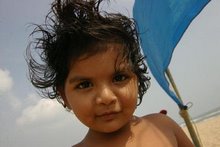Mr. S. Palanichamy taking us on a tour down the main road of Vannampatti.

The village children out for a break from class; they almost trampled me when I pulled out my camera...

lunchbreak "tiffen" (food), menu: Chilli-fried chicken,veg khurma with chapatti... i love any kind of fried chicken. Masala-fried fish was also on today's special.

Mr. S. Palanichamy with his family and neighbors in the Vannampatti village. Everyone in this village is either tied to or sustained by cotton farming.The men in the background in the button- ups are Mr. Vishvaasam and Mr. Saravanan, the guys that hosted me and bring education and knowledge to the farmers.

Mr. S. Palanichamy's daughters with the cotton that has been picked and cleaned.

Mr. Jeyaraj with Mrs. Jeyaraj showing off the grandbaby

Vannampatti Catholic school children. There are also Hindu and Muslim families in the village.

There are 16 different farmers "groups". Mr Jeyaraj is the president of the local farmers federation and showed me around his farm.

This rooster was very curious and hated my camera

Indigenous cotton variety

Peanuts and banana plants...here the peanuts are simply called "groundnuts" in english.

Mr. S. Palanichamy with some cotton...fresh picked!

The Fair Trade vision here is based on four different components that are the basis of the NGO's work, my interest, and the well being of all the people involved . They are:
1. No child labor is used
2. No use of chemical pesticides in the growing of the cotton
3. Equal wages for equal work
4. Social development, meaning the farmers meet together on a regular basis, share ideas, discuss problems and create relationships.
One other thing that should be noted; the farmers use something called "menu" (FYM farmyard menu) which is a mix of organics as fertilizer consisting of compost and manure that eliminates the use of chemical fertilizers as well...this cotton is not "certified" organic...but will be in the future.(we are working on that)
In 2006, 80 farmers were involved in the fair trade program. Due to climatic problems and social conflicts, 40 farmers produced cotton on 100 acres (2.5 acres each). The farmers grow the cotton along with the pulse called
"Bengal Gram" (chickpeasचिक्क्पास ) for consumption. The cotton is a very old, indigenous variety that has been in this valley for a long time, but they are now experimenting with some new ones that boost production very carefully. The local NGOs are monitoring the progress... but for now this variety is what I am using for my market bags. It is spun into a 10-15 ply size which is not recommended for clothing or bedding but is still perfect for my needs. This year there are 177 farmers from 8 villages in the fair trade program, and growing!




















































